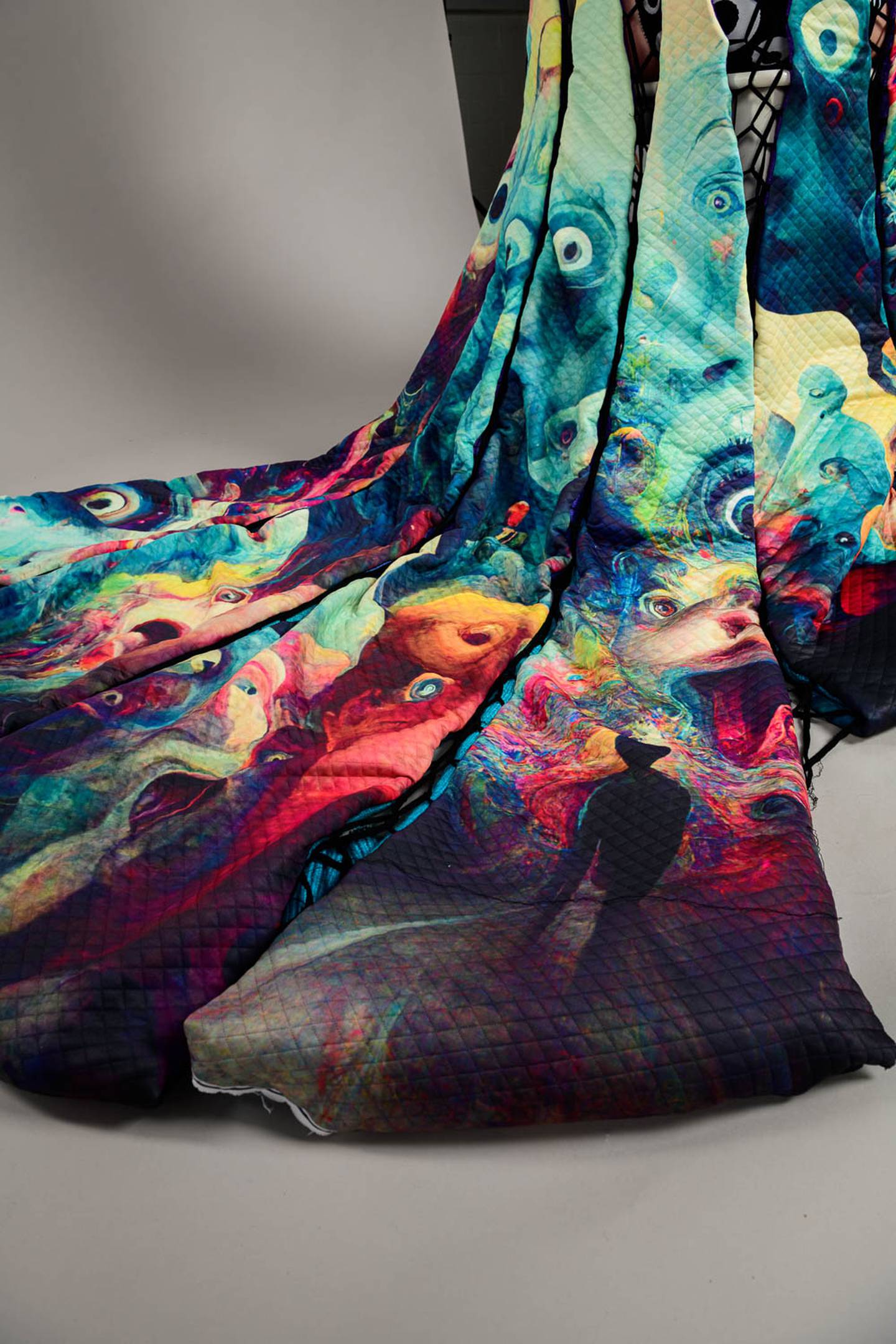
Maxime Touze Black’s instructors at London’s Central Saint Martin initially expressed hesitation when he used artificial intelligence to create the designs for his final collection. They were unsure how the concepts would translate into finished garments, according to the recent graduate of the master’s programme in fashion design.
This was several months ago, before the release of the latest generation of Midjourney and some other AI tools capable of producing realistic images from a text prompt. Black now does most of his work with Midjourney, but at the time he trained an AI model he made with help from a friend in the tech space on a dataset of 3,000 photos he shot of himself styled in clothing he owned, borrowed or found at thrift stores. The new images it produced appeared slightly distorted, almost like computer glitches, which is part of what attracted Black. He then turned them into actual clothes.
“I think it was a good first step, especially for a school like that, that is so traditional,” he said. “It wouldn’t surprise me if any of the students from the year below me are using [AI] right now, and I think [the school] would be very open to it now.”
Fewer than you’d think, though. Multiple educators told BoF that many students, despite being from a generation stereotyped as born technophiles, still view AI with distrust.
Fashion schools are on the front lines of preparing the next generation of talent to enter an industry that could be shaken up by generative AI. The recent surge of powerful new AI image generators has made it much easier for anyone with a computer to churn out new design concepts. The situation is sparking both excitement about the possibilities and fear it could displace workers and remove human creativity from design.
Schools such as Parsons School of Design in New York and the London College of Fashion have long-standing elective classes where students can gain exposure to designing with AI if they choose. Others are moving more slowly and haven’t formally developed any related courses.
But it isn’t just reluctance on the part of schools, said Peter Jeun Ho Tsang, who helped develop IFA Paris’ MBA programme in fashion tech. In the programme, students travel from all over the world to learn the craft of fashion, often with the dream of landing a job with a luxury house. They want to learn skills like traditional pattern cutting. Technology doesn’t usually figure into the plan.
“It might come up as a conversation piece here and there, but it won’t necessarily be a focus just yet — and that’s for the business students [and] marketing students. For the design students, that’s just a complete no-go,” Tsang said.
Technology As a Means, Not an End
Educators who are discussing AI say they’re trying to get students to push their creativity with AI, not use it as an easy solution.
“I’ve been encouraging students to not be so suspicious of it by having more philosophical talks, where we talk about the nature of these technologies, why they were developed, how they can in a sense further our humanity, not snatch anything away from it,” said Margarita Louca, digital lead for the fashion programme at CSM. “But there are definitely still some students that are quite angry that I’m even engaging with this.”
Even those in favour of introducing fashion students to generative AI say it’s important they take a critical approach. Louca noted they now have a number of students experimenting with it and encourage them to use it for exploring new possibilities rather than quickly creating a final product. She pointed to Black as a good example and said she’s not a fan of students just using Midjourney to pump out fully formed ideas. (Black said Louca was supportive of him using AI when he first brought it up.)
At Nottingham Trent University, an undergraduate student, Imogen Hawkes, used Midjourney in combination with more fashion-specific tools to create a collection of knitwear designs. Hawkes made the decision to use the technology on her own, but Ian McInnes, principal lecturer in the fashion knitwear design programme, said in an email that the school has been looking at ways students can use AI to help inform their designs. It’s still up to the designer, however, to decide if the output is novel and relevant, he added.

“The challenge is giving them the discernment to understand what is a derivative work versus what is a transformative work,” said Jeongki Lim, a professor at Parsons who for a few years has been teaching an interdisciplinary class on designing with AI that has attracted students in the fashion programme. “Having a machine that so quickly creates a lot of derivative work forces both the students and ourselves to develop the ability to discern what’s interesting and what’s new and novel — like a pressure cooker.”
Lim’s approach to teaching AI design has changed with the spate of new tools because they make the process so simple. He also discusses labour and copyright issues with students, since generative AI is trained on large volumes of data scraped from the internet that can include the work of designers and artists who haven’t given explicit consent.
Preparing For the Future
Educators aren’t just there to nurture students’ creativity. They’re also charged with preparing them for a future in fashion’s workforce, which could one day conceivably entail using generative AI.
“Undoubtedly, job roles are going to be affected,” said Matthew Drinkwater, head of the Fashion Innovation Agency at London College of Fashion. “The fact that we talk about prompt engineering as a speciality is something that, even a year ago, we wouldn’t be discussing.” (Prompt engineering refers to creating text prompts to elicit the desired outcomes from AI systems.)
The agency, whose purpose is to anticipate which technologies will be significant three to five years in the future and explore their possibilities, began experimenting with image-generating AI systems in 2019. Back then, it had to scrape the internet to compile its own datasets and use high-powered computers to generate new imagery.
“For us, it was looking very early into that just to ensure that there was access to those tools, there was an understanding of those tools: how they worked, what the datasets were, how [students] might begin to understand the images that they’re seeing and how they’re generated and how to implement it in a workflow,” Drinkwater said. “The tools available to them now are going to empower a change in the process of how they create.”
But even at LCF and other schools with courses offering students experience with generative AI, the classes are electives, meaning students only take them if they’re already interested in the subject. Louca, who started in her role less than two years ago, said she’s still figuring out CSM’s approach to technology, but in her view the school shouldn’t have separate technology courses and should instead embed it into the curriculum, focusing on general skills and mindset more than specific software, which can quickly become out of date.
Whatever approach they take, educators thinking about generative AI are hoping to get students to engage with a significant new technology rather than to fear or ignore it. As Lim at Parsons put it, “We’re not an ostrich with our head in the sand.”



